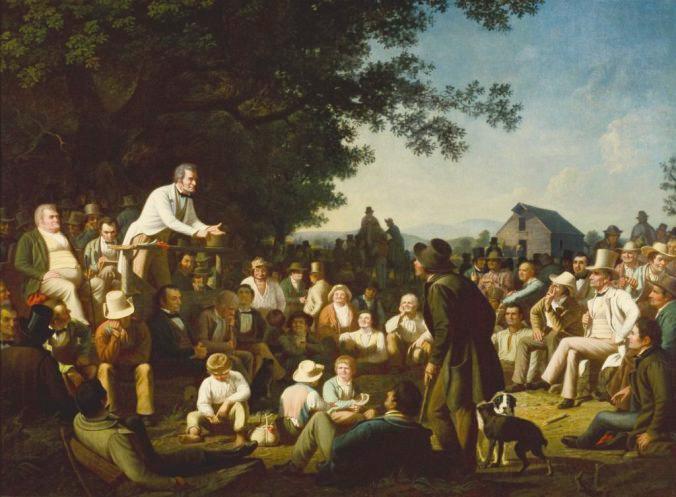
United States 1854 Congressional Midterm Election

Figure 1.--George Caleb Bingham (1811–79) was an American artist whose paintings of American life in the frontier lands along the Missouri River provide us some of few contemporary image of the eaerly American frontier. They are relentlessly optimistic showing a vigorous free people, building a new nation based on freedim and dmocracy. Bingham in the 1850s painted his election series, three diiferent paintings. This is his 'Stump Speaking' paining completed about 1853-54. Art historians see a less than optimistic vision in his deopictioin of the three main individuls (past, current, and future). But taken together the three paintings are a paean of democracy and national strength. But there is not an inkling in these paintings of what was happening in America, the country tearing itself apart over the issue of slavery. It is ironic that Bingam in his several decades of work idealing freedom and democracy never touched on the issue of slavery.
|
|
Elections continued to be complicated in the United States. There was no one single national electionn date. The major issue in the midterm election as it had been in 1850 and 1852 was slavery. The sopecufic manifestation was the passage of the Kansas–Nebraska Act and the resulting Bleeding Kansas violence. The Act infuriated Northern voters already upset over the Compromose of 1850 because it repealed the Missouri Compromise of 1820 and this opened the Federal territories to slavery. The Pierce Administration and Democrats in Congress suppprted the Act. Thus the Democrats lost heavily in the midterms. This meant that the one institution holding the Union together, the Democratic Party, was badly damaged.
The Democrats lost 75 House seats and the majority. The Whigs, however, did not benefit, presumably because they were so equivocable on slavery. The Whigs lost 17 searts, and as they were a minority to begin with, they ceased to be a creditable opposition. The party that befefitted was the new Know Nothings/American Party which went from no House seats to 51 seats. The other new party, the Republicans, also benefitted gaining 33 seats. They only had 4 seats before the election. The new People's Party won 9 seats. The Free Soilers lost their 2 House seats. Free Soilers like the
Whigs were gravitating toward the Republican Party.
The different opposition parties combined to chose Nathiel P. Banks, a Know Nothing as speaker. The Know Nothings did well in North and South by avoiding the volitle slavery issue and advovating restrictions on immigration, especially from Catholic areas (Ireland and Germany). Immigration from Catholic southern Europe was not yet important.
The election was a tuning point in Americam political history. The Whigs were clearly failing. This would be the last election in which they would be a force of any importance in large measure because they were no longer even a minor force in the South. The Democrats continued to be the majority party, but The Republican were beginning to win seats from the Whigs and Free Soilers. Whigs in the South opposed to secession called themsleves the 'Opposition Party'. The Party while attempting to avoid the issue of slavery acquired the taint of northern abolition.
The state legislators chosing the Senate candidates were also in a volitile mood. They only returned five of the twenty-one Senators up for election to the Sente. The Denmocrats lost 3 seats, but still returned a large minority. The Whigs lost 4 searts and as they were already a small minority, ceased to be a creditable opposition. The new Republicans won their first 3 Senate seats. The Free Soilers lost 2 of their 4 seats. The Know Nothings won one Senate seat which was not up for relection.
CIH

Navigate the Children in History Website:
[Return to the Main U.S. 19th century election page]
[Return to the Main U.S. election page]
[Return to the Main U.S. presidential page]
[Return to the Main U.S. political party page]
[Return to the Main U.S. history page]
[About Us]
[Introduction]
[Biographies]
[Chronology]
[Climatology]
[Clothing]
[Disease and Health]
[Economics]
[Freedom]
[Geography]
[History]
[Human Nature]
[Ideology]
[Law]
[Nationalism]
[Presidents]
[Religion]
[Royalty]
[Science]
[Social Class]
[Bibliographies]
[Contributions]
[FAQs]
[Glossaries]
[Images]
[Links]
[Registration]
[Tools]
[Children in History Home]
Created: 9:02 PM 9/22/2018
Last updated: 5:15 AM 3/15/2019



